[SHEH-nin Blahnk]
Characteristics
Chenin Blanc originated in France's Loire Valley, likely in the Anjou subregion, which today makes the world's most acclaimed Chenins. The grape's frontiers have expanded, to South Africa, where it’s also known as Steen, as well as to some regions in the U.S., most notably California.
Chenin Blanc is early-budding, mid-ripening, and grows successfully in varied soil types, including silex, schist, sand and clay. It's made in a range of styles and sweetness levels. In France, Chenins emphasize the grape's high acidity, orchard and citrus fruit flavors, and floral notes, like honeysuckle. This is the case with Savennières, home solely to dry versions, as well as with Vouvray, where dry, off-dry and sweet bottlings are all made. Chenin Blanc is susceptible to botrytis, enabling the production of richer dessert-wine styles, such as those from Coteaux du Layon and Quarts de Chaume.
In the New World, South Africa and California in particular, Chenin Blanc is mostly made in a dry style, but with riper, sometimes tropical fruit. However, a handful of South African producers use the grape in their dessert-style "straw wines." Globally, producers often opt to age Chenins in oak, as well as to subject it to malolactic fermentation and aging on its lees, which emphasizes brioche, toast and nutty notes.
Where it's grown

Chenin Blanc icons
- Loire
- South Africa
Suggested food pairings
- Loire (dry)
- Seafood pasta
- Salmon with asparagus
- South Africa
For more on Chenin Blanc
- Loire Valley: A River Runs Through It
- South Africa: Charting Their Own Course
- Scenic Route: California's Lesser-Known White Wines
- Loire Valley vintage chart
- South Africa vintage chart
Get scores and tasting notes for recently rated Chenin Blancs












